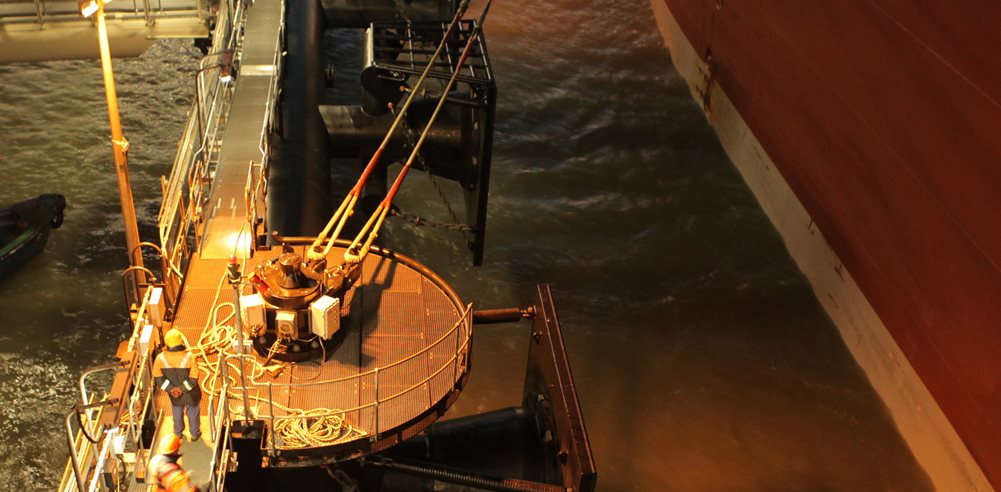CHAPTER 02
A Smarter Approach to Safety & Performance
Whilst diverse and varied in its applications, the LNG industry is especially – and necessarily - safety conscious, committed to best practice and premium solutions.
Improving Interface Management
Managing interfaces at various stages of the LNG supply chain is vital to safe transfer. This is a considerable challenge when you reflect on the diversity of stakeholders involved in the process: the jetty marine operator, the mooring crew, tugboat operators, pilot and onshore control room team.
It is somewhat surprising then, given that the industry is usually so focused on ‘best practice’ that interface management is often not specified until late in the project process. It’s a catch 22 situation: in a market that is evolving so rapidly ‘best practice’ must be constantly re-established.
However, there must be no compromise to safety. A huge challenge lies in optimizing performance while meeting the rigorous safety standards set up by SIGTTO, OICMF and other industry bodies. Trelleborg works extremely closely with these industry bodies to set the standards. We have already built – and continue to build on – a proven track record for best practice.
Whilst global demand for LNG continues apace, emerging markets evolve, and new
opportunities
continue to bring new entrants into the game, increasing the pressure on the
LNG
industry to maximize operational performance.
FSRU
One key issue lies in the emergence of FSRU, where interface management becomes especially complex. Operational oversight and communications between three parties is essential, requiring elements of conventional jetty mooring and docking, as well as offshore ship-to-ship mooring systems.
In the case of an FSRU project, a comprehensive overview should be undertaken, and the design requirements of all stakeholders aligned and coordinated. However, due to the timelines and execution methodologies typical to these projects, the jetty requirements and FSRU docking and mooring requirements often suffer from splitting the scope, resulting in system fragmentation and compromising safety and operational efficiency.
The Ship-to-Ship docking and mooring scope is a shipyard led activity, with a brief purely focused on the conversion of the vessel or a new build specification. The Civil Engineering EPC responsible for the design and construction of the jetty has an emphasis on site cost control, rather than the need to integrate the overall docking and mooring systems. Through no fault of the shipyard, or the EPC, considering these two elements in isolation jeopardizes the entire integration of the overall system.
Subsequently, it’s important that an experienced third party is present to
provide
oversight of the total integration requirements of the system.
The Role of Specification
There is a need for correct specification at the early stages of a project to ensure long term performance and the safety of the project. The ability to understand materials and applications plays a large part in optimizing safety and performance and ensuring the right solution for the job.
Products must meet globally differing regulatory requirements and suppliers must understand and integrate all necessary standards into their solution.
At Trelleborg, we remain committed to working closely with regulatory bodies to remain at the forefront of product innovation. And we commit to working with customers for the long term to support the project lifecycle through maintenance and training.
In the LNG arena, where downtime is at an absolute premium, facilities need first class support, on site, as and when necessary. We commit to a 24/7 worldwide service on critical products so that our customers are reassured we will be there when we are needed.
Fender Specification
Materials and application play a key part in fender performance, so correct specification at the outset will optimize performance. For example, super cone fenders are robust, and this high performance means they can cope with the increased stress from FSRU. While foam fenders are virtually unsinkable and in the case of an LNG spill are resistant to damage from low temperatures. This makes them better suited for some FLNG projects.

HALO Fenders
Trelleborg Marine & Infrastructure's operation and Teekay Marine Solutions present a new, premium pneumatic fender offering focused on meeting the demands of the ship-to-ship (STS) transfer market and the wider marine industry.
Combining the strength and experience of two industry leaders, HALO Fenders are fully compliant with ISO 17357-1:2014. A wide range of fender sizes are stocked in strategic locations around the world, allowing fast and convenient delivery. Fenders are available to buy or rent, backed up by exceptional technical and service support.
HALO Fenders bring together Trelleborg’s manufacturing capability and Teekay’s operations expertise, providing customers with a single point of contact from product specification, to delivery, through to comprehensive field services, including fitting of chain tire nets, maintenance of fenders and provision of all required certification and documentation to meet major oil company requirements.

SmartMoor Quick Release Hooks
SmartMoor Quick Release Hooks (QRH) are the foundation for today’s modern mooring systems, delivering improved safety and mooring security. Designed for hazardous area operation, they comply with international standards and feature remote release and load monitoring to improve safety.
Case Study
Improving performance and safety
One of the world’s most advanced integrated gas production systems in the world chose Trelleborg’s Tugger Winches as part of an integrated SmartMoor Quick Release Hook system. This enabled operators to be removed from danger zones, reduced mooring times to improve facility throughput and minimized operational costs.
The integrated SmartMoor QRH system significantly improved efficiency, with lines able to be retrieved 50% quicker than a traditional capstan. Safety was also enhanced with free spooling allowing hands free operations and a torque limiting clutch reducing the risk of heaving line breakage.